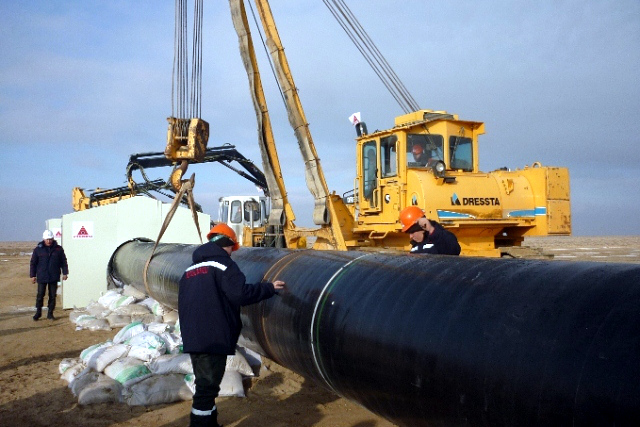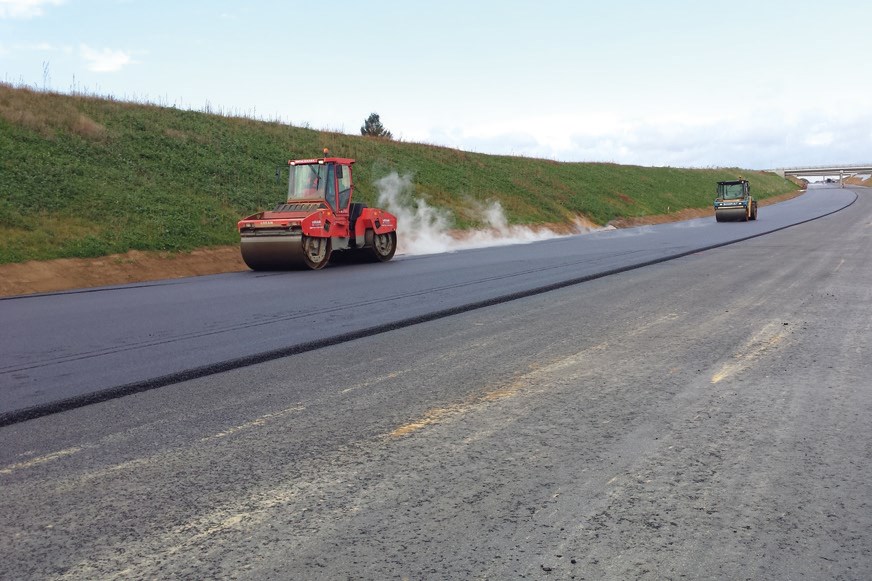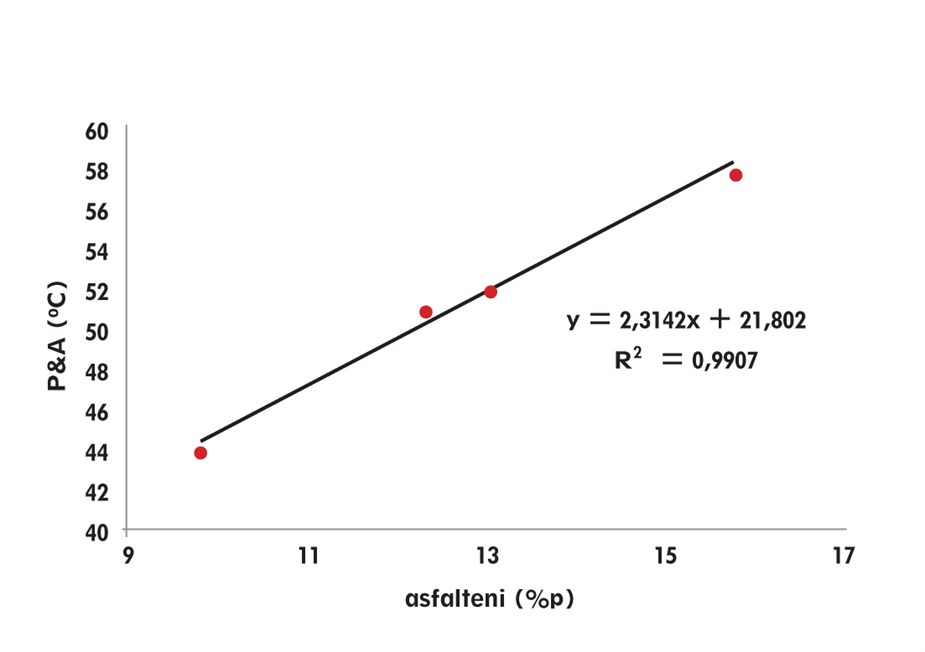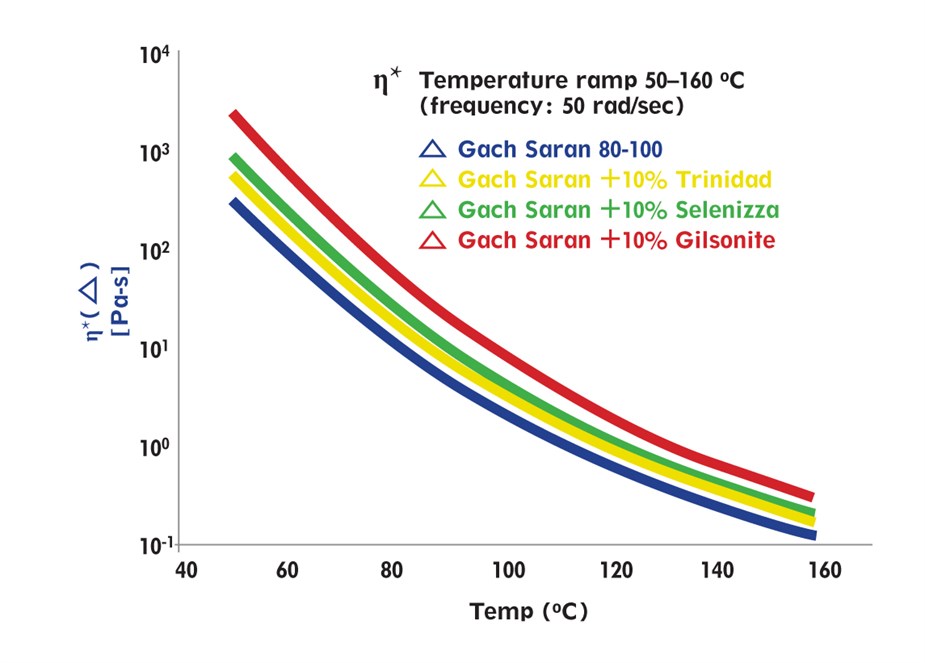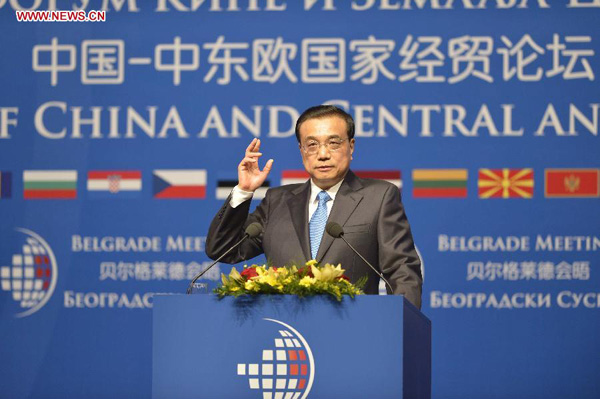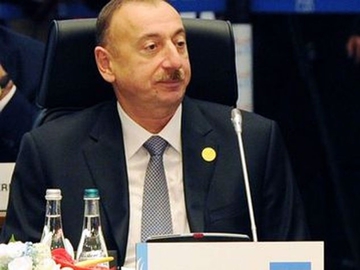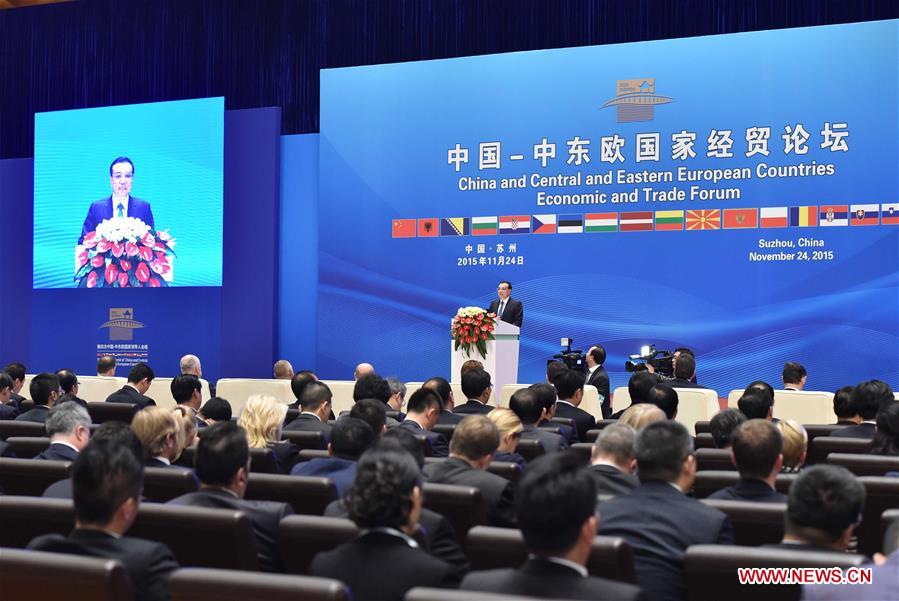
Cooperation between China and Central and Eastern European Countries
 On 24 November 2015, the 4th Summit of China and Central and Eastern European Countries (hereinafter referred to as “CEECs”) was held in Suzhou, China. Premier Li Keqiang of the People’s Republic of China, President Andrzej Duda of the Republic of Poland, Prime Minister Edi Rama of the Republic of Albania, Chairman of the Council of Ministers Denis Zvizdic of Bosnia and Herzegovina, Prime Minister Boyko Borisov of the Republic of Bulgaria, Speaker of Parliament Josip Leko of the Republic of Croatia, Prime Minister Bohuslav Sobotka of the Czech Republic, Prime Minister Taavi Roivas of the Republic of Estonia, Prime Minister Orban Viktor of Hungary, Prime Minister Laimdota Straujuma of the Republic of Latvia, Prime Minister Algirdas Butkevicius of the Republic of Lithuania, Prime Minister Nikola Gruevski of the Republic of Macedonia, Prime Minister Milo Djukanovic of Montenegro, Prime Minister Aleksandar Vucic of the Republic of Serbia, Prime Minister Miro Cerar of the Republic of Slovenia, Vice Prime Minister and Minister of Economy, Commerce and Relations with the Business Environment Costin Borc of Romania and Deputy Prime Minister Lubomir Vazny of the Slovak Republic attended the meeting. They expressed appreciation and gratitude to China for the efforts it had made as the host country to ensure the success of the meeting. Representatives of other parties, including the EU, Austria and the European Bank for Reconstruction and Development, were present as observers.
On 24 November 2015, the 4th Summit of China and Central and Eastern European Countries (hereinafter referred to as “CEECs”) was held in Suzhou, China. Premier Li Keqiang of the People’s Republic of China, President Andrzej Duda of the Republic of Poland, Prime Minister Edi Rama of the Republic of Albania, Chairman of the Council of Ministers Denis Zvizdic of Bosnia and Herzegovina, Prime Minister Boyko Borisov of the Republic of Bulgaria, Speaker of Parliament Josip Leko of the Republic of Croatia, Prime Minister Bohuslav Sobotka of the Czech Republic, Prime Minister Taavi Roivas of the Republic of Estonia, Prime Minister Orban Viktor of Hungary, Prime Minister Laimdota Straujuma of the Republic of Latvia, Prime Minister Algirdas Butkevicius of the Republic of Lithuania, Prime Minister Nikola Gruevski of the Republic of Macedonia, Prime Minister Milo Djukanovic of Montenegro, Prime Minister Aleksandar Vucic of the Republic of Serbia, Prime Minister Miro Cerar of the Republic of Slovenia, Vice Prime Minister and Minister of Economy, Commerce and Relations with the Business Environment Costin Borc of Romania and Deputy Prime Minister Lubomir Vazny of the Slovak Republic attended the meeting. They expressed appreciation and gratitude to China for the efforts it had made as the host country to ensure the success of the meeting. Representatives of other parties, including the EU, Austria and the European Bank for Reconstruction and Development, were present as observers.
Participants at the meeting (hereinafter referred to as “the Participants”) commended the substantial progress that had been made in the past year in the cooperation between China and Central and Eastern European Countries (hereinafter referred to as “16+1 cooperation”), in particular in the implementation of the Belgrade Guidelines for Cooperation between China and Central and Eastern European Countries (see Annex), welcomed and supported the important agreement between the Chinese and EU leaders on establishing the China-EU Connectivity Platform, as well as on developing synergies between the Belt and Road initiative of China and the Investment Plan for Europe, and between 16+1 cooperation and China-EU relations. The Participants expressed their readiness to seize these opportunities and work together to further advance 16+1 cooperation.
The Participants jointly formulated and issued, on the theme of “New Beginning, New Domains, New Vision” , the Suzhou Guidelines for Cooperation between China and Central and Eastern European Countries.
1. The Participants support Latvia in hosting the 5th China-CEEC Summit in 2016.
2. The Participants welcome the Medium-Term Agenda for Cooperation between China and Central and Eastern European Countries issued during the 4th China-CEEC Summit, and are ready to implement it in light of their respective realities, needs and priorities.
3. 16+1 National Coordinators’ Meetings will be held in China and Latvia respectively in 2016.
4. The Participants support the establishment of a mechanism of quarterly meetings between the Secretariat for Cooperation between China and Central and Eastern European Countries (hereinafter referred to as “the Secretariat”), its member organizations and CEEC embassies in China. The Participants support more efficient use of the Secretariat’s website.
5. Cooperation on Connectivity
(1) The Participants note that the cooperation document on the Belt and Road initiative was signed between the governments of China and Hungary and that there is an interest to have similar documents between China and other CEECs, with a view to enhancing cooperation on regional connectivity.
(2) The Participants welcome the commencement of the regular express cargo railway transit from China to Poland. The Participants encourage and support similar links between China and other CEECs and appreciate the efforts assuring possibility that the goods could be transported in both directions. The Participants support the further development of the Eurasian Land Bridge and welcome the establishment of logistic centers in CEECs.
(3) The Participants appreciate the major progress that has been made in the modernization of the railway line connecting Budapest and Belgrade and welcome the joint efforts of the relevant parties for early completion of the project.
(4) The Participants welcome China, Hungary, Serbia and Macedonia in organizing the 2nd working group meeting and a workshop under the Framework Agreement on Cooperation in Facilitating Customs Clearance Among the Chinese, Hungarian, Serbian and Macedonian Customs in Budapest in 2016, streamlining customs clearance procedures for goods in transit and means of transport and increasing cooperation on customs clearance facilitation for the China-Europe Land-Sea Express Line.
(5) More CEEC customs are encouraged to take part in the third phase of the China-EU Smart and Secure Trade Lanes Pilot Project.
(6) The Participants welcome and support Serbia in leading the efforts to establish a China-CEEC association on transport and infrastructure cooperation and welcome the participation of relevant Chinese and CEEC institutions, businesses and organizations on a voluntary basis.
(7) The Participants welcome and support Latvia in leading the efforts to establish a China-CEEC secretariat on logistics cooperation and welcome the participation of relevant Chinese and CEEC institutions, businesses and organizations on a voluntary basis.
(8) The Participants welcome the relaunch of direct flights between Beijing and Budapest and the launch of direct flights between Beijing and Prague in addition to existing Beijing-Warsaw connection. The Participants support deepening civil aviation cooperation between China and more CEECs.
(9) The 1st China-CEEC Transport Ministers’ Meeting will be held in Riga, Latvia, in 2016.
6. Economic and Financial Cooperation
(1) The 2nd China-CEEC Ministerial Meeting on Promoting Trade and Economic Cooperation will be held in Ningbo, China, in June 2016.
(2) The China-CEEC Investment and Trade Expo will be held in Ningbo, China, in June 2016 during the China International Consumer Goods Fair.
(3) The 3rd Meeting of the China-CEEC Investment Promotion Agencies Contact Mechanism will be held in China in 2016.
(4) The Participants welcome and support Romania’s initiative of setting up a Center for Dialogue in energy-related projects. The 1st meeting of the Center will be organized in Romania in 2016.
(5) The Participants welcome and support the participation of Chinese and CEEC SMEs in the China International Small and Medium Enterprises Fair 2016.
(6) China will attend the Brno International Engineering Fair in the Czech Republic in 2016 as a partner country.
(7) The China Investment Forum will be held in the Czech Republic in 2016.
(8) The Participants welcome and support the organization of an economic forum focused on infrastructure, tourism and industrial capacity cooperation between China and CEECs, to be held in Sarajevo, Bosnia and Herzegovina, in the first half of 2016.
(9) Qualified CEEC financial institutions are welcomed to apply to be indirect participants in the RMB Cross-border Inter-bank Payment System (Phase One).
(10) The Participants welcome the ongoing work leading to the signing of a statement of cooperation on crisis management between the China Banking Regulatory Commission and the Czech National Bank and the signing of an MoU on regulatory cooperation between the China Banking Regulatory Commission and the Polish Financial Supervision Authority.
7. Agricultural and Forestry Cooperation
(1) The 11th China-CEEC Agrotrade and Economic Cooperation Forum will be held in China in 2016, in conjunction with the 2nd meeting of the China-CEEC Association on Promoting Agricultural Cooperation.
(2) An exhibition area will be set aside for top-quality CEEC agro-products at the 14th China International Agricultural Trade Fair to be held in Yunnan Province, China, in the second half of 2016.
(3) The Chinese side will create a free-of-charge exhibition space for top-quality CEEC wines and spirits at the National Agriculture Exhibition Center.
(4) The Participants welcome the signing or the work leading to the signing of the relevant protocols on quarantine of animal and animal-originated products to be exported to China between China and Serbia, Macedonia, Slovenia, Lithuania, Poland and Estonia respectively. The Participants support China and more CEECs in expanding trade of agro-products and food.
(5) The Participants support Slovenia in leading the efforts to establish a China-CEEC coordination mechanism for forestry cooperation. The 1st China-CEEC High-Level Meeting on Cooperation in Forestry will be held in Slovenia in May 2016.
(6) The Participants welcome China and CEECs in signing agreements on strengthening cooperation in water resources and agricultural irrigation.
8. Cooperation on Science, Technology and Health
(1) The 3rd China-CEEC Seminar on Innovation, Technology Cooperation and International Technology Transfer will be held in China in 2016.
(2) The Participants encourage and support the establishment of a virtual China-CEEC technology transfer center, and the role of the secretariat will be assumed by the relevant Chinese and Slovak institutions.
(3) The Participants support the environment protection authorities of China and CEECs in enhancing exchanges under the framework of 16+1 cooperation and discussing the possibility of cooperation with a third party.
(4) The 2nd China-CEEC Health Ministers’ Forum will be held in China in 2016.
(5) CEEC health professionals will be invited to visit China in 2016 and to participate in seminars on global health diplomacy, healthcare system reforms and health promotion, with a view to strengthening academic and professional exchanges.
(6) CEEC medical and health businesses will be invited to China for exhibitions on health services and medical devices, with a view to promoting cooperation in the medical industry.
9. People-to-People Contacts and Cultural Exchanges
(1) The Secretariat will continue to invite senior CEEC officials for a trip to China in 2016.
(2) The 4th China-CEEC Education Policy Dialogue and the 3rd meeting of China-CEEC Higher Education Institutes Consortium will be held in China in 2016.
(3) A China-CEEC forum on cooperation in the field of art and the 2nd China-CEEC Summer Dance Camp will be held in China in 2016.
(4) Famous CEEC artists and composers as well as artistic directors of international opera festivals in CEECs will be invited to visit China in 2016.
(5) The Participants support China and CEECs in carrying out joint projects on translation and publication of each other’s literary works. China welcomes CEECs to be the Country of Honor as a group at the Beijing International Book Fair in 2016.
(6) The 1st China-CEEC Cultural and Creative Industries Forum will be held in Belgrade, Serbia, in 2016.
(7) The 1st China-CEEC Experts’ Forum on Intangible Cultural Heritage will be held in Krakow, Poland, in 2016.
(8) The Participants welcome the Chinese Academy of Social Sciences in leading the efforts to establish a China-CEEC think tanks network.
(9) The 4th China-CEEC High-Level Symposium of Thinks Tanks will be held in 2016.
(10) The Participants encourage and support mutual visits by Chinese and CEEC journalists in 2016.
(11) A China-CEEC seminar of sinologists will be held in 2016.
(12) The Participants welcome the organization of the Travel 2016 expo and the related professional conference in March 2016 in Budapest. China will participate in the expo as the Country of Honor. The Participants support the opening of the regional center of the China National Tourism Administration in Budapest.
(13) The 3rd China-CEEC High-Level Conference on Tourism Cooperation will be held in Croatia in 2016.
10. Cooperation at the Local Level
(1) The 3rd China-CEEC Local Leaders’ Meeting and the China (Hebei) International Economic and Trade Fair 2016 will be held in Hebei Province, China, in 2016.
(2) The 2nd working meeting of the China-CEEC Association of Provincial Governors will be held in Hebei Province, China, in 2016.
(3) The Participants encourage and support exchanges and cooperation between mayors of Chinese and CEEC capital cities.
Annex:
Implementation of the Measures of the Belgrade Guidelines for Cooperation between China and Central and Eastern European Countries
1. In January 2015, the customs clearance facilitation cooperation mechanism for the China-Europe Land-Sea Express Line among the Chinese, Hungarian, Serbian, Macedonian and Greek Customs was officially established.
2. From February to October 2015, the Chinese Art Festival was held in Lithuania, Estonia and Latvia.
3. In March 2015, the launch ceremony of the Year of Promotion of China-CEEC Tourism Cooperation was held in Budapest, Hungary.
4. In March 2015, the 1st working group meeting under the Framework Agreement on Cooperation in Facilitating Customs Clearance Among the Chinese, Hungarian, Serbian and Macedonian Customs was held in Shanghai, China.
5. In April 2015, the Chinese Ministry of Foreign Affairs appointed the Special Representative for China-CEEC Cooperation.
6. In April 2015, the 1st meeting of the China-CEEC Business Council was held in Katowice, Poland.
7. In April 2015, the Riga High Level Conference on Transport and Logistics and the 3rd ASEM Transport Ministers’ Meeting was held in Riga, Latvia.
8. In May 2015, the 1st Customs Control Techniques Workshop for the China-Europe Land-Sea Express Line among the Chinese, Hungarian, Serbian and Macedonian Customs was held in Shanghai, China.
9. In May 2015, the 33rd Meeting of the Central Bank Governors’ Club of the Central Asia, Black Sea Region and Balkan Countries was held in Shanghai, China.
10. In May 2015, the 1st Meeting of China-CEEC Association of Provincial Governors was held in Hebei Province, China.
11. In May 2015, the Beijing-Budapest regular flight was launched.
12. In May 2015, heads of customs of China, Hungary, Serbia and Macedonia met in Xi’an, China, and signed the Cooperation Action Plan for 2015-2016.
13. In May 2015, China and Hungary signed an MoU on nuclear energy cooperation.
14. From May to June 2015, the Chinese Ministry of Culture organized Chinese performing arts organizations to purchase programs from Hungary, Serbia and Romania.
15. In June 2015, a delegation of CEEC journalists visited Zhejiang Province, Henan Province and Beijing, China.
16. In June 2015, the 1st China-CEEC Investment and Trade Expo was held in Ningbo, China.
17. In June 2015, the launch ceremony of the China-CEEC Association on Promoting Agricultural Cooperation and the 1st Meeting of Ministers of Agriculture was held in Sofia, Bulgaria.
18. In June 2015, the 1st China-CEEC Health Ministers’ Forum was held in Prague, the Czech Republic.
19. In June 2015, the 1st TCM center in the Czech Republic was established.
20. In June 2015, the cartoon series Panda and the Little Mole co-produced by China and the Czech Republic was premiered in the Czech Republic.
21. In July 2015, the 5th China-CEEC National Coordinators’ Meeting was held in Beijing, China.
22. In July 2015, a delegation of senior CEEC officials visited Sichuan Province, Yunnan Province and Beijing, China.
23. From July to August 2015, the 1st China-CEEC Summer Dance Camp was organized in Shaanxi Province, China.
24. In August 2015, Bank of China Prague Branch was opened.
25. From August to September 2015, the 2nd China-CEEC High-Level Conference on Tourism Cooperation was held in Bled, Slovenia.
26. In September 2015, the 10th China-CEEC Agrotrade and Economic Cooperation Forum was held in Budapest, Hungary.
27. In September 2015,the 3rd China-CEEC Education Policy Dialogue and the 2nd working consultation of the China-CEEC Higher Education Institutes Consortium were held in Warsaw, Poland.
28. In September 2015, the Beijing-Prague direct flight was launched.
29. In September 2015, the 2nd China-CEEC Seminar on Innovation, Technology Cooperation and International Technology Transfer was held in Bratislava, Slovakia.
30. In October 2015, an exhibition area dedicated to CEECs was created at the 11th China International Small and Medium Enterprises Fair in Guangzhou, China.
31. In October 2015, the Workshop on Customs Clearance Procedures of Transit Goods and Risk Management among the Chinese, Hungarian, Serbian and Macedonian Customs was held in Skopje, Macedonia.
32. In October 2015, a delegation of artistic directors of CEEC jazz festivals visited China.
33. In October 2015, the Seminar on Radio and Television Program Production for Central and Eastern European Countries was held in Shanghai and Hunan Province, China.
34. In October 2015, the 6th China-CEEC National Coordinators’ Meeting was held in Warsaw, Poland.
35. In October 2015, the 2nd China-CEEC Young Political Leaders’ Forum was held in China.
36. In November 2015, the 2nd China-CEEC Cultural Cooperation Forum was held in Sofia, Bulgaria.
37. In November 2015, the China Investment Forum was held in Prague, the Czech Republic.
38. In November 2015, China and Slovenia signed an MoU on the establishment of the China-CEEC coordination mechanism for forestry cooperation.
39. The 3rd China-CEEC High-Level Symposium of Think Tanks will be held in Beijing, China, in December 2015.
40. China and Romania will sign a new agreement on avoidance of double taxation as appropriate; China signed cooperation agreements on education with the Czech Republic, Estonia, Lithuania and Romania respectively; China signed cooperation agreements on quality inspection with Lithuania, Macedonia, Poland, Romania, Serbia and Slovenia respectively; China signed documents on cultural exchanges and cooperation with Bulgaria, Croatia, Latvia and Poland respectively; China signed with Romania an MoU regarding the relevant nuclear power project.

